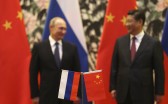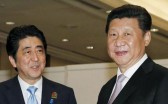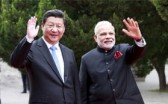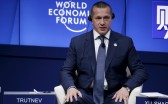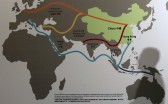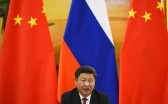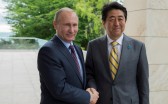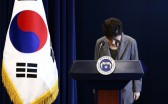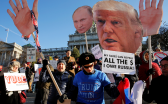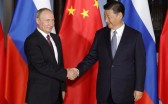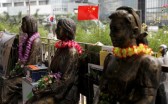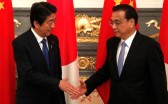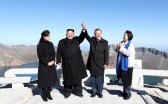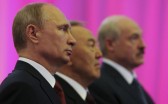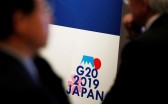Russia’s ability to become an independent, geopolitical center in Eurasia is closely tied to the position of other countries and geopolitical tendencies in the region. The idea of a special role for Eurasia in world economics and politics has long been discussed by various theoreticians, among them Halford Mackinder and Nicholas Spykman, who considered control over Eurasia the key to world domination. Thus, the aim of policies by the West became not to allow non-Western powers to gain control over the Eurasian space, at first the Russian empire, and after its fall, the USSR or the Soviet-Chinese alliance. Thanks to its achievement in deepening the rift between China and the USSR, Washington forged relations with Beijing after the Sino-Soviet conflict peaked at the end of the 1960s.
The collapse of the Soviet Union, called by Vladimir Putin the “greatest geopolitical catastrophe of the 20th century,” led to instability in the region and gave forces outside of the region a chance to use the opportunity to strengthen their influence here. Zbigniew Brzezinski, the noted theoretician of American dominance, wrote openly about this: “For America the chief geopolitical prize is Eurasia. For half a millennium, world affairs were dominated by Eurasian powers and peoples who fought with one another for regional domination and reached out for global power. Now a non-Eurasian power is preeminent in Eurasia – and America’s global primacy is directly dependent on how long and how effectively its preponderance on the Eurasian continent is sustained.”1
In this way, American analysts immediately imposed geopolitical limits on the development of Russia. Even if Russia (or another big country, such as China, or, let us say, Germany), were to be friendly to the US, it would not be allowed to be strong enough to dominate in Eurasia. Only the US should be allowed to do it. About the need to limit their power Henry Kissinger directly stated: “Geopolitically, America is an island off the shores of the large landmass of Eurasia, whose resources and population far exceed those of the United States. The domination by a single power of either of Eurasia’s two principal spheres—Europe and Asia—remains a good definition of strategic danger for America. Cold War or no Cold War. For such a grouping would have the capacity to outstrip America economically and, in the end, militarily. That danger would have to be resisted even were the dominant power apparently benevolent, for if the intentions ever changed, America would find itself with a grossly diminished capacity for effective resistance and a growing inability to shape events.”2 Thus, the danger for the US was considered to be not different political regimes, but simply all major, autonomous and influential states, such as these.
Considering the collapse of the Soviet Union as a victory in the Cold War, giving them a chance to resolve all geopolitical problems, the United States and its allies exaggerated their strength. Policies to simultaneously apply pressure to Russia and China alienated both countries and strengthened the tendency in both to draw closer. 3 Precisely for this reason the idea of establishing a Greater Eurasian partnership, aimed at intensifying cooperation among the governments of this region across the breadth of Eurasia, was proposed by Russian experts and advanced officially by the presidents of Russia Putin and Kazakhstan Nazarbayev, and then supported in China. It is obvious that conversations today among some Western experts about caution in China regarding this initiative are based either on wishful thinking or poor knowledge of sources.
ChinaandGreaterEurasia
Support for the idea of a Greater (or comprehensive) Eurasian partnership is affirmed in several official Russo-Chinese documents, among which is the joint declaration of 2016.4 During the visit to Russia by Chinese premier Li Keqiang in November 2016, Russian prime minister Dmitry Medvedev said that Russia was continuing to work with China on forming a comprehensive Eurasian partnership that would include EEU and SCO member states. According to Medvedev, Russia and China had conducted a joint study on what should serve as the basis of that partnership. He and Li Keqiang discussed and approved the results of that study during their meeting and instructed experts from the two countries to formulate the economic basis of the project.5
At a meeting with Putin in Moscow on May 25, 2017 Chinese foreign minister Wang Yi said that China welcomed and supported “Mr. President’s personal initiative on creating a Eurasian partnership.” According to Wang, the Chinese Commerce Ministry and the Russian Economic Development Ministry are currently examining possibilities for developing a Eurasian trade partnership and are preparing a relevant agreement.6
On July 4, 2017 during Xi Jinping’s visit to Russia, Chinese minister of commerce Zhong Shan and Russian minister of economic development Maksim Oreshkin signed the Joint Declaration of Feasible Study on Eurasian Economic Partnership Agreement. According to an official Chinese commentary, the signing of the declaration “is a significant trade and economic achievement of President Xi Jinping’s visit to Russia, showing the steadfast determination of China and Russia to deepen their mutual beneficial cooperation and promote trade liberalization and regional economic integration. It also shows the common willingness for a comprehensive and high-level trade and investment liberalization arrangement which opens to other economics in the future. It will inject new strength for the comprehensive strategic partnership of the two countries.”7
Most Chinese experts are also supportive of the project or at least the idea of closer cooperation with Russia in Eurasia. An article, located on the web-site of China’s State Information Center, argues that “practical realization of the idea of an ‘All-encompassing Eurasian partnership,’ advanced by the Russian president V.V. Putin, has great strategic significance for the reconstruction of the world structure, for agreement on the Eurasian continent, and also for China’s deep entry into the world economy.”8 One Chinese analyst wrote that “Promotion of the ‘One belt, One Road’ initiative has had a significant impact on Russia. In Russia, they are also thinking about how to achieve linkage. There is some overlap between the ‘One Belt, One Road’ and Putin’s recent proposal to establish a partnership in Greater Eurasia. In effect, they create an opportunity for cooperation between China and Russia in the Eurasian mainland region, to expand the reach of Sino-Russian cooperation. Accordingly, the concept of a Greater Eurasian partnership, “is the result of the ongoing Russian effort to improve its strategic environment by constantly adjusting its general strategy – a course that at various times has led it to promote such projects as the ‘North-South transport corridor’ and the Eurasian Economic Union.”9
Li Ziguo, explaining Russia’s motives, basically agrees with the mainstream Russian view. Li shows that ever since 1960 leaders of the Soviet Union and Russia envisaged fostering a “greater European family,” and as late as 2010 the then president Dmitry Medvedev put forward a draft of a new European Security Treaty and Prime Minister Vladimir Putin proposed a new European economic system “from Lisbon to Vladivostok” as moves towards realizing the Greater Europe ideal. But “Western countries perceive themselves to be the victors of the Cold War and have constantly imposed strategic pressures on Russia, forcing it to accept its total defeat in the geopolitical confrontation with the West. Russia eventually realized that it would be impossible to integrate into the Western world.”10 This became the reason for Russia to turn to Eurasia.
According to Li Ziguo, “The Greater Eurasian Partnership (GEP) is an initiative by Russia for pan-regional economic cooperation in the context of a new economic situation. The initiative, while mainly focusing on promoting the Eurasian Economic Union (EEU) and with certain geopolitical flavor, takes China as an important partner by way of synergy with the China-proposed Silk Road Economic Belt. The GEP may, to a certain extent, overlap with China’s Belt and Road Initiative (BRI), but its concept of openness, inclusiveness and coordinated development is in line with the spirit of the BRI. Therefore, the GEP could go hand-in-hand with the Chinese initiative and ensure development and stability in the Eurasian region while also serving as a lever for reshaping future global order.”11
The chairman of the Chinese Association for East European, Russian, and Central Asian Studies Li Yongquan, recognizing a certain complexity in the process of docking the GEP with the Chinese initiative of BRI, nevertheless believes that linking the Russian and Chinese development strategies “is crucial not only to building the Eurasian Economic Partnership, but also, in some ways, to that organization’s future prospects.” He also is confident that ASEAN can be part of the new entity, adding that “In the future, aligning the development strategies of China and the Russian-led EAEU will drive the construction of the Eurasian Economic Partnership.”12
Zhao Huasheng in a 2017 article is a bit more cautious about the Russian initiative, since it “is not clear whether the Greater Eurasian Partnership will be a long-term strategy or merely a transitional policy for Russia.” He is also doubtful “that Russia has strong enough power to advance the Greater Eurasian Partnership, therefore it remains unclear just how far the Greater Eurasian Partnership can go.” However, according to Zhao, “rationality and necessity still exist in advancing the economic, diplomatic, and security cooperation in the greater Eurasian region.” He concludes: “Greater Eurasian cooperation coincides with China’s national interests, especially in that it is conducive to the construction of the Belt and Road Initiative. China should, together with Russia and other countries concerned, push forward greater Eurasian cooperation.”13
In a recent article Zhao is more positive, arguing that in Greater Eurasia China is a participant in a moving force; here, before us, there is no question of making a political choice. 14 He makes the following recommendation: “China and Russia should bring the process of docking BRI to the stage of practical realization, seriously think about the start of negotiations on a free trade zone between China and the EAEU, practically advance regional economic integration within the framework of the SCO, realize in practice their corresponding agreements in projects of cooperation, and jointly respond to problems of the regional economy and development. In the process of forging Greater Eurasia for China, Russia and India have the most important special interests. China should even more creatively use the mechanism of CRI (China, Russia, India) to widen its scope of contents, lessen Sino-Indian contradictions, strengthen confidence, and intensify cooperation among China, Russia, and India on regional questions.”15
Today, one can say with full confidence that Beijing supports the Russian idea of closer cooperation in Greater Eurasia on an official level and has become involved in the realization of this project and the examination of variants for its realization. This project, in full measure, can be called not Russian, but Russo-Chinese.
OtherEurasian partners
As for other countries of the region, their attitude toward the project is sufficiently positive, but not everywhere has an official position already been worked out, and in some places, there is simply not enough information on it. Kazakhstan, in the person of its first president Nazarbayev, was one of the initiators and active exponents of the idea. Naturally, there are some distinctive features of its interest. It pays more attention to economic effectiveness and has come out against politicization of any Eurasian programs.
In an interview, K.K. Tokaev, the new president of Kazakhstan, remarked, “We consider that the idea of Greater Eurasia—in a broad understanding of this term—opens horizons for activization of the economic ties of Asia and Europe, and it can become a fundamental formation of a new system of international relations on the Eurasian space. The processes occurring on our mega-continent, in my opinion, form a new geopolitical reality…” Speaking of Central Asia, Tokaev noted, “Close cooperation of the countries of the region, linked to the bonds with the strategic partner Russia, are a serious factor supporting peace, stability, and security in Eurasia. In other words, realization of this goal is impossible without Russia.” He concluded that we would like to see Greater Eurasia as a “united Eurasian space of security and prosperity.”16
Kyrgyzstan as a member of the EEC is a natural part included in the formation of Greater Eurasia through the mechanism of docking the EEC and the Silk Road Economic Belt (SREB). Tajikistan also will participate as a member of the SCO and active partner of SREB, as will other members of these groupings. Of late, Uzbekistan began to more actively open itself to the outside world and broad international integrationist initiative. In a recent article two of its former, high-ranked diplomats mention the idea of Greater Eurasia, advanced by Russian experts, and also the idea of a Greater Eurasian partnership, which they call, for some reason, Chinese, and remind people that Uzbekistan always occupied a central place in the development of this region.17 As for a major country such as India, there is still no official position on the Greater Eurasian partnership project. Nevertheless, Indian experts on the whole are reacting positively to the idea of active cooperation with Russia in Eurasia, not least of all, in light of the need to balance the growing influence of China.
Thus, Raj Kumar, justlikehisChinesecolleagues, acceptsthat GEP “signifies Russia’s disillusionment with its efforts to integrate with Europe prompting Moscow’s pivot to the East.” He argues: “Since Chinese economic resources could influence the region more than the Russians, there is ample scope for Russia to cooperate with India at a regional level in order to avoid too much dependence on China. This will also strengthen India-Russia economic ties, which have been weak ever since the Soviet Union disintegrated. The two countries could cooperate in areas like Central Asia, South East Asia, Afghanistan, Russia’s Far East and the Arctic to further boost their relationship under the GEP initiative. A weakened Russia is not in India’s favour and New Delhi must help its strategic partner’s initiative to find feet in the region at a time when India has been a vocal critic of China’s BRI.”18 Nandan Unnikrishnan and Uma Purushothaman even suggest that India should join the EEU since this “will give access to its goods to an entire geographic space through a single tariff. Joining it would also allow India to use and contribute to the internal rail and road networks, which link the members of the EEU.”19
Conclusion
The emergence and development of the community of Greater Eurasia is not exclusively a Russian plan or aspiration. It is an objective process, founded on basic world geopolitical tendencies. Its foundation is Russo-Chinese closeness, propelled by the rise of China, the collapse of the USSR and strengthening of a new Russia, and the active stimulation by attempts of the US and its allies to contain the development of both states within the rubric of the international system under Western domination. Other states in the region have their own interests, which also drive them to ever more active participation in the establishment of a new Eurasian system, free from the interference of forces from outside the region.
To some degree, Greater Eurasia fills a vacuum, which arose after the collapse of the USSR, as a result of which in the 1990s for a certain time the illusion of unipolarity arose. Yet, most states of Eurasia found themselves uncomfortable in a unipolar world, feeling undefended from all the ever-growing demands of the US and its allies. The demand for a multi-polar world grew and then became a reality. Greater Eurasia became part of this emerging multipolar world.
Whether Russia can occupy a place as an autonomous center in this world depends, first of all, on how successful is its domestic development. As for the external conditions for this scenario, it is now clear that the only possibility is active participation in Eurasian integration, in the establishment of Greater Eurasia, and in the deepening of cooperation with China, India, and the states of Central, South, and Southeast Asia. Moscow’s attempts to play an autonomous role at the foundation of the establishment of Greater Europe were decisively rejected by the West, apparently forever. Greater Eurasia is premised on the idea of pluralism of civilizations, non-interference in the internal affairs of each other, and mutual respect for the values and approaches to domestic development which creates more favorable conditions for Russia. Whether Russia will be able to use this for establishing an independent center of power or will fall under the influence of another due to its own weakness depends solely on itself.

